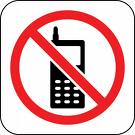My apologies to Guy Ben-Ner, the Israeli video artist who has represented Israel at the Venice Biennale and whose 2000 video, Moby Dick, was recently acquired by the Museum of

Modern Art. He has a show at MASS MoCA, but when I was there on Saturday, I fled — not because of his work, but because some young man was in the galleries bleating into his cell phone. Guards are few at MASS MoCA, and no one stopped him from chatting away during the video.
But this is not just a plea to museums to enforce the no-cell-phones ban, though it is that, too.
Rather, the situation started me thinking about art and focus. My one-time colleague at The New York Times, the retired music critic Bernard Holland, used to stir up dozens of reader letters at the mere mention of a cough in the audience. This happened not once or twice, but — as I found when I just searched his work at the Times — in 14 articles he wrote over the years touching on the problem. Everyone agreed that coughers should not be tolerated.
A cough is often involuntary. What would Carnegie Hall denizens say about the gallery-goers who nowadays think nothing of pulling out their cells while others are trying to look at art?
In a world in which we are all multi-tasking and suffering from many demands on our attention, looking at art remains different. So should consuming other forms of art.
Yet, according to an article by Ellen Gamerman in Saturday’s Wall Street Journal, theaters are also becoming a battleground. Some members of Broadway audiences are calling out lines from their seat, taking distracting photographs and videos, texting and even, in one case, shouting to an actor to wait until the shouter could sit down before continuing her monologue.
Gamerman’s article outlines two theories as the cause — either people are paying so much for tickets that they take the liberty of doing whatever they please, or discounted tickets have allowed in people who do not know how to behave in a theater.
Her article includes this anecdote:
When patrons misbehave nowadays, audiences aren’t shy about playing police. Ben Admonius, a 26-year-old New Yorker, says that when a cell phone went off near him at “The Norman Conquests,” the crowd’s reaction was louder than the ring. “It was like lions jumping on a rabbit,” he says.
Perhaps the reaction, at least, has nothing to do with money.
I wouldn’t go so far as to say the museums and performing arts venues are always a sanctuary from the hustle-bustle of life, but it is remarkable that they are one of the few places, aside from houses of worship, where cell phones are usually not tolerated. Add some libraries and that may be the sum total of public places where we can regularly invest time contemplating the meaning of what we’re seeing or hearing (or life).
Yet one theater director in the WSJ article proposes making theaters more “relaxed, less traditional” by allowing cell phones at a theater space this summer.
I beg to differ: Art can be a counterforce to all the other influences shortening our attention span. To all arts venues, I say keep the bans — and please enforce them.
